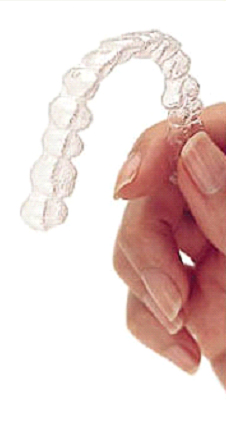The Invisalign System is a new orthodontic treatment that can straighten your teeth while avoiding the compromised appearance associated with wearing the traditional braces. Developed specifically for patients with adult dentition who are no longer experiencing significant jaw growth, the Invisalign System is virtually invisible and it’s removable.
The Following information, with the exception of the “Device description” and “Procedure “ sections, is routinely supplied to anyone considering orthodontic treatment. Although orthodontic treatment can provide the benefits of healthy teeth and attractive smile, you should also be aware that orthodontic treatment has limitations and potential risks that should be considered before undergoing treatment.
Device Description
 The Invisalign System, developed by Align Technology, consists of a series of clear polymer; removable appliances (aligners) that move your teeth in small increments from their original state to a more ideal treated state. Some patients may also require bonded aesthetic attachments (small, tooth-colored, dental composites) and/or elastics on their teeth to facilitate specific dental movements. The Invisalign System combines your orthodontist’s diagnosis and treatment plan with sophisticated computer graphics technology to develop your series of customized aligners. You typically wear the aligners in pairs, one on your upper dental arch and one on your lower dental arch. Each aligner fully covers your teeth and is virtually invisible when in place. You wear each pair of aligners as instructed by your orthodontist.
The Invisalign System, developed by Align Technology, consists of a series of clear polymer; removable appliances (aligners) that move your teeth in small increments from their original state to a more ideal treated state. Some patients may also require bonded aesthetic attachments (small, tooth-colored, dental composites) and/or elastics on their teeth to facilitate specific dental movements. The Invisalign System combines your orthodontist’s diagnosis and treatment plan with sophisticated computer graphics technology to develop your series of customized aligners. You typically wear the aligners in pairs, one on your upper dental arch and one on your lower dental arch. Each aligner fully covers your teeth and is virtually invisible when in place. You wear each pair of aligners as instructed by your orthodontist.
Procedure
You will undergo a routine orthodontic pre-treatment examination (including x-rays, photographs and study models). Your orthodontist will take impressions of your teeth and send them, along with a prescription, to the Align laboratory. Align technicians will follow your orthodontist’s prescription to create a series of customized aligners. The Align laboratory will then mail the series of aligners back to your orthodontist. The total number of aligners varies depending on the complexity of your orthodontic case. The aligners are individually numbered and will be dispensed to you by your orthodontist with specific instructions for use. You will wear your aligners for approximately 20 to 22 hours per day, removing them only to eat and to brush and floss. Each aligner will be designed to guide your teeth to a more ideal position. Approximately every one to two weeks, you will switch to the next aligner in the series. Treatment duration typically lasts 6 to 30 months. Over the course of treatment your orthodontist will monitor your progress through a series of follow-up appointments.Benefits
 The Invisalign System offers you an attractive alternative to braces. The anticipated patient benefits of the Invisalign System are:
The Invisalign System offers you an attractive alternative to braces. The anticipated patient benefits of the Invisalign System are:
- Improved aesthetics. Aligners are nearly invisible when worn
- Reduced discomfort. Aligners do not cause the intraoral abrasive discomfort associated with conventional braces.
- Ease of use. Aligners require little or no maintenance or care, and are generally discarded after two weeks of wear.
- Improved oral hygiene. Aligners allow for normal brushing and flossing, tasks that are impaired by conventional braces.
Risks and Inconveniences
The use of the Invisalign System in your treatment may involve the kinds of complications or problems that can occur with conventional orthodontic treatment. Many of these problems and inconveniences can occur without orthodontic treatment, but the risk is greater to an individual wearing an orthodontic appliance. The risks associated with conventional or Invisalign System orthodontic treatment may include the following:- Periodontal disease, tooth decay or permanent marking (e.g. decalcifications) on the teeth can occur if orthodontic patients eat foods with excessive sugar and/or do not brush their teeth frequently and properly.
- In some patients the length of the roots of the teeth may be shortened during orthodontic treatment. Some patients are more prone to this happening than others. Usually this does not have significant consequences, but on occasion it may become a threat to the longevity of the teeth.
- The health of the bone and gums which support the teeth may be affected by orthodontic tooth movement, particularly if a condition already exists and in some rare cases where a condition does not appear to exist.
- Teeth may shift their position after treatment. Faithful wearing of retainers at the end of orthodontic treatment should reduce this tendency. Throughout life, the bite can change adversely from various causes, including growth changes, playing of musical instruments and other oral habits. All of their causes may be out of the control of the orthodontist. Occasionally, problems may also occur in your temporomandibular joint (jaw joint), causing joint pain, headaches or ear problems.
- For many patients, orthodontic treatment temporarily affects their speech and they may experience a lisp, although any speech impediment caused by the aligners usually disappears within a few days.
- A tooth may have been previously traumatized or may have fillings that can cause tooth nerve damage. Orthodontic tooth movement may on occasion aggravate this condition and in rare instances may lead to the need for root canal treatment and caps (crowns).
- Orthodontic appliances may be accidentally swallowed or aspirated, or may irritate or damage oral tissues (however, there is no greater risk with the aligners than with other appliances, such as dentures or orthodontic retainers). The gums, cheeks and lips may be scratched or irritated by blows to the mouth. Post-adjustment tenderness (or in the case of the Invisalign System, tenderness experienced after switching to the next aligner in the series) should be expected and the period of tenderness or sensitivity varies with each patient and the procedure performed.
- Oral surgery (e.g. tooth extraction) may be necessary in conjunction with orthodontic treatment, especially to correct crowding or severe jaw imbalances. If such surgeries are necessary, risks associated with treatment and anesthesia should be discussed with the oral surgeon.
- Atypical formation of teeth may limit the ability to achieve the desired result.
- It may take longer than expected to complete treatment. Excessive or deficient bone growth, poor cooperation in wearing the appliance the required number of hours per day, not using the aligners as indicated, lost or broken appliances, and missed appointments can lengthen the treatment time and affect the quality of the end results or the ability to achieve the desired results.
General medical conditions can affect orthodontic treatment. You should advise your orthodontist of any medical conditions you have.
Swollen, red gums can often be the result of having teeth that are crowded or too widely spaced. Unfortunately, these are also signs of periodontal disease. When teeth are properly aligned, it helps the gums fit more securely around the teeth, allowing for the strongest and healthiest defense against potential periodontal problems. That’s where Invisalign comes in. The comfortable and clear aligners gently and gradually begin to move your teeth into the proper position — without unsightly brackets and wires.
One of the biggest challenges of having braces is removing all the food that gets trapped in the brackets and wires. This can often lead to plaque buildup and eventually tooth decay. With Invisalign, the aligners are removable, so it’s easy to continue brushing and flossing your teeth the way you normally do.
Think of your teeth as a window to the health of your body. Your teeth and gums — and how they look to others when you smile—say a lot about your overall health. If you’re taking good care of both, you’re probably taking good care of the rest of you.
Tooth decay and gum disease are caused by bacteria. Left untreated, they can cause mouth sores, tender or bleeding gums, bad breath, and possible tooth loss. Studies by the American Dental Association have shown that oral infections can also lead to other more serious ailments such as heart disease,2 stroke,3 pneumonia4 and diabetes5. Invisalign aligners make daily oral hygiene easier, thus reducing the risk of possible problems. And correctly aligned teeth can also alleviate the issues that can be caused by an improper bite, speech or chewing difficulties, jaw problems, and increased wear on the tooth enamel. Invisalign effectively addresses all of these orthodontic issues, so you’ll have the confidence of a great smile and increase the likelihood of improved oral health.